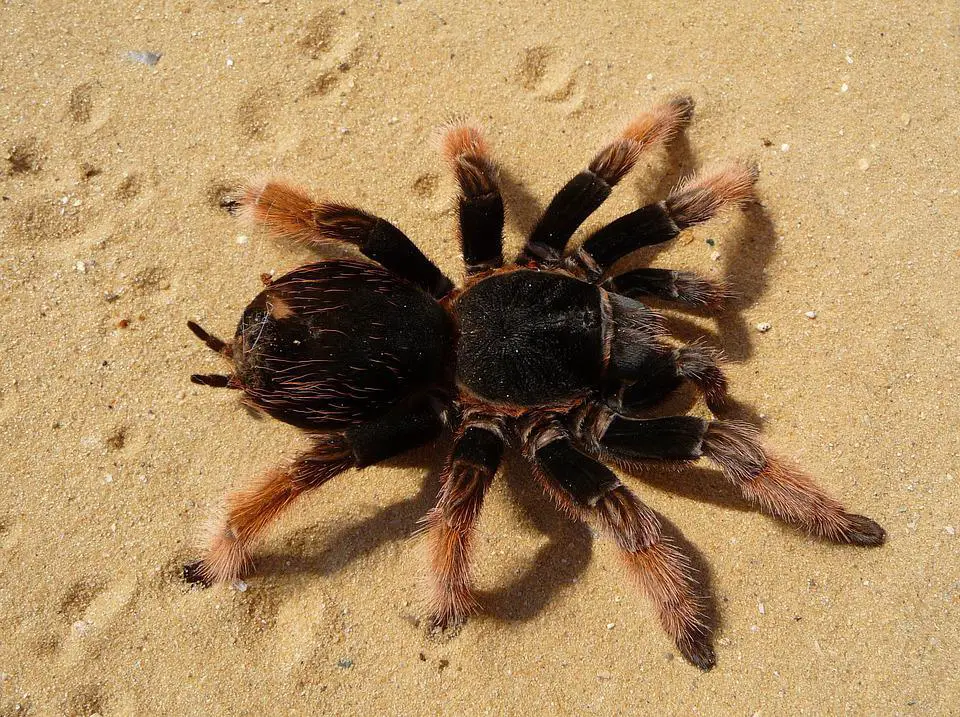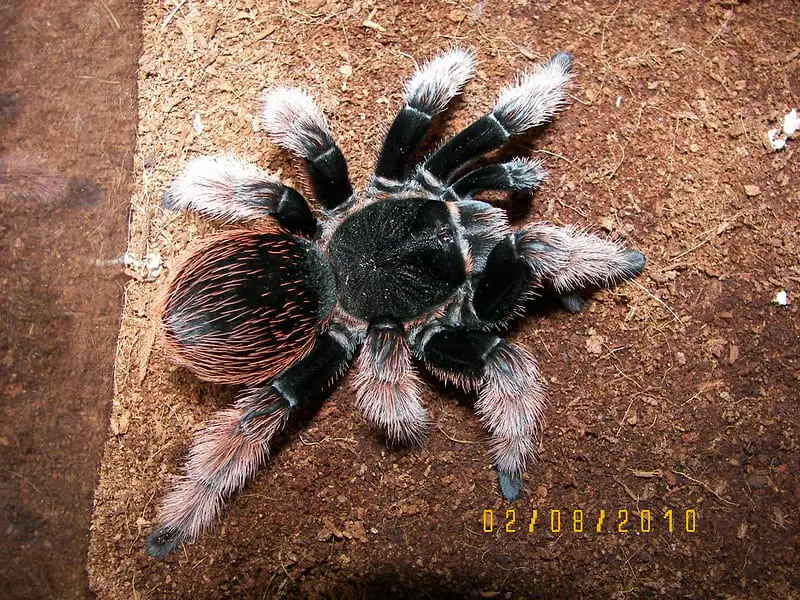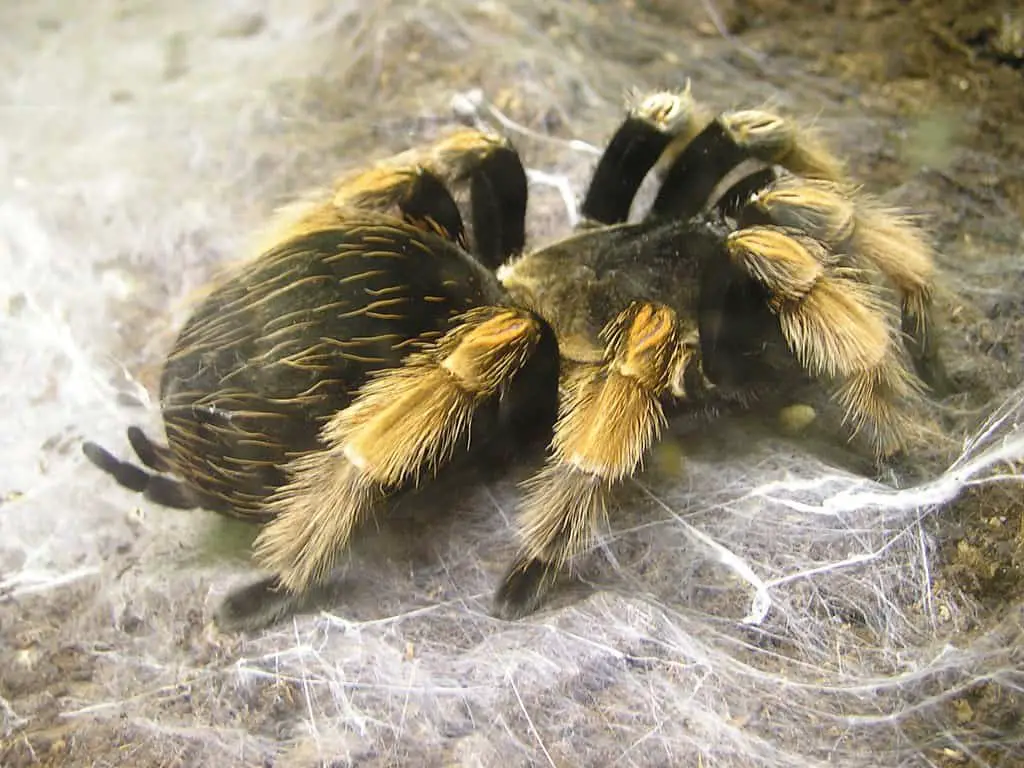The Mexican Pink Tarantula (Brachypelma Klaasi) is often considered the best species for beginners. This New World breed is docile, has a long lifespan, and is stunning to look at. The hairy pink legs and calm demeanor make it very popular among collectors.
If you’re considering getting one of these for your own collection or want to start in the hobby and this spider caught your eye, here’s everything you need to know about this beautiful tarantula.

Mexican Pink Tarantula Care Sheet
| Species Name | Brachypelma Klaasi |
| Family Name | Theraphosidae |
| Common Name | Mexican Pink Tarantula |
| Category | New World |
| Type | Terrestrial |
| Native Location | Mexico |
| Body length | 2.5 inches (7 cm) |
| Leg Span | 6 inches (16 cm) |
| Growth Speed | Slow/Medium |
| Urticating Hairs | Yes, type I and III |
| Social | Solitary |
| Diet | Insects: crickets, roaches, mealworms |
| Temperature | 70 to 85 degrees Fahrenheit |
| Humidity | 65 to 75% |
| Life Expectancy | Female: 25 to 30 years / Male: 4-5 years |
| Experience required | Beginner |
| Minimum tank size | 12″ x 12″ x 18″ |
Mexican Pink Tarantula Overview
The Brachypelma Klaasi has been in the hobby for so long that it has many other pseudonyms. It’s sometimes called Mexican Pink Beauty Tarantula and Acapulco Lesser Orange Tarantula; However, its most popular name is the easiest one, the Mexican Pink Tarantula.
She’s a terrestrial spider, an opportunistic burrower, which means that she creates burrows occasionally. Also, she’s more on the nervous side, so she prefers to run and hide instead of assuming a threat posture and getting ready to defend herself.
The spider is native to the Jalisco and Nayarit regions in Mexico, but she’s bred and sold worldwide.
Appearance & Varieties

The Mexican Pink Tarantula is sought after for the beautiful pink tones she displays on her legs. A dark body perfectly contrasts the pink hairs over her legs and parts of her cephalothorax.
The only difference between male and female specimens is the size. Males won’t grow as big as females. However, the difference between males and females in size when they’re adults is so significant that it’s not difficult to tell them apart.
Spiderlings will often have orange instead of pink colors. However, over time they will develop the color that gives them their name as they grow.
Price
The cost of a Mexican Pink Tarantula varies with the sex and age of the specimens. Slings and juveniles, which are always unsexed, will cost around $30-60 and $35-130 respectively.
Male adults will go for $60-$145. Female adults are much more expensive and will usually cost between 135$ and 200$.
These are not costly species due to their high supply from breeders. However, they’re an endangered species in the wild, so make sure you don’t get one from a poacher taking them out of their natural habitat.
Behavior and Temperament
Part of what makes the Mexican Pink Tarantula a popular choice for a pet is that it’s diurnal. Unlike most species, which are nocturnal and will spend most of their active hours at night, this species will be up and around during the day.
Like other members of the Brachypelma genus, the Mexican Pink Tarantula is a docile spider, sooner to hide than to fight. However, unlike some other members of the Brachypelma genus, this tarantula isn’t likely to kick out hairs unless stressed.
Therefore, if you’re careful, she’s a spider you can handle in your hands and show off to your friends. Her easy demeanor is the biggest reason behind her classification as a spider for beginners. They are capable of biting, but only do so in extreme cases when they feel very threatened and feel like they have no other option. Luckily, they do not have very potent venom.
Caring for a Mexican Pink Tarantula

Tarantulas are well-known for being low-maintenance pets. They do not need a whole lot to thrive. Give them a good tank, good substrate, and good food, and you’ll go a long way in making them happy! With that being said, there are some things to know to properly care for your eight-legged friend.
Tank
The Mexican Pink Tarantula is terrestrial, so tanks must be broader and longer than tall to avoid falls from high places.
A vial is enough for spiderlings as long as they have enough substrate and hydration. Juveniles should have a tank of at least 8x8x8. As adults, anything smaller than 12x12x12 is a bad idea.
It’s better to have a tank of at least 18x18x12, so they can have plenty of room to move, hide, and show off their beautiful colors. Your Mexican Pink Tarantula will be very uncomfortable when she doesn’t have a place to hide, so give her enough hiding places.
A piece of bark, some artificial plants, moss, and leaves will help her feel safer and avoid stress. Also, it’ll help her build her web, which will make it easier for her to feed, and it’s part of her ideal burrow.
Temperature and Humidity
The Mexican Pink Tarantula lives in desert and scrubland climates. She’s comfortable in temperatures between 70°F and 85°F, and humidity between 65% and 80%.
Substrate
The Mexican Pink Tarantula is an opportunistic burrower, which means she needs enough substrate to burrow into.
For spiderlings and juveniles, three inches of substrate should be enough to be comfortable. However, pre-adults and adults will need four to five inches of substrate to be able to burrow.
They’re not very picky with their substrate. A standard mix of peat moss, coconut fiber, vermiculite, and dirt is good enough for them. It’ll be alright as long as it’s clean and soft enough for them to dig into.
Watering
The Mexican Pink Tarantula lives in a dry environment, so her substrate doesn’t need to be as wet as that of other species.
As a sling, dripping some water down the substrate is enough to hydrate them. From juveniles onward, they should have a water dish in their tanks; make sure to refill it every time it’s empty. You should drip some water down one of the tank’s walls and allow it to dry completely before doing it again to make sure there’s some moisture under the surface.
Social
There are some tarantula species that can live in groups, but the Mexican Pink Tarantula is not one of those. Attempts to do so will most likely end in cannibalism.
Do not try to house more than a single Mexican Pink Tarantula in a single enclosure as this will likely not end well!
Diet of a Mexican Pink Tarantula
The Mexican Pink Tarantula is large enough to eat small birds in the wild, but a diet of roaches and crickets is enough for her in captivity.
The Mexican Pink is a bulky spider, and she eats more often than most others do, but pay attention to its abdomen to avoid overfeeding. If the abdomen keeps getting larger and rounder, decrease the frequency or amount of food you give them.
Spiderlings should be fed a flightless fruit fly or a baby cricket three times per week. Juveniles will eat two medium crickets or one small roach two or three times per week. Adults should eat once a week and are happy eating two B. dubia roaches or eight large crickets.
Don’t be worried if she randomly stops eating. Like other tarantulas, this species will stop eating a few days before a molt and start eating a couple of days after her fangs have regained their strength; you should wait one week after molting to start feeding her again.
Health & Lifespan

The Mexican Pink Tarantula has one of the longest lifespans of all the species. Females can live for up to 30 years in captivity! Males are less lucky though, and typically only live for 4 to 5 years.
To keep your spider in prime condition make sure that you keep its enclosure clean. Remove uneaten food, prevent mold, and do not let your spider climb too high. Falls are something that is very dangerous for these spiders due to their heavy bodies.
Handling a Mexican Pink Tarantula

Due to the Mexican Pink Tarantula’s docile nature, you can indeed handle them. Do keep in mind however that tarantulas don’t really get anything out of you handling them. They might tolerate it, but it’s not really they particularly enjoy.
You must understand a few things before handling any tarantulas for the first time. First, don’t just grab them with your hand and lift them since this might stress them out.
Just lay your hand calmly in front of her and, using a brush or a pen to nudge her lightly forward, allow her to get onto your palm. Once in your hands, understand that you shouldn’t make sudden movements with them.
Also, and this is very important, do not drop them. Tarantulas, especially terrestrial tarantulas such as the Mexican Pink, aren’t made to fall from high places (such as your hand). If you ever drop one, she’s at risk of rupturing her abdomen. This is an injury that very few tarantulas survive, so be careful!
Breeding Mexican Pink Tarantulas
Make sure your MPTs are well fed and in comfortable temperature and humidity before attempting to mate them. Females are much larger than males, and it’s known that cannibalism after mating is particularly common in this species, so the female mustn’t be hungry.
Also, if the female molts between mating and laying the eggs, the eggs won’t be fertilized. Therefore you should wait at least 4-6 weeks after the female’s last molt to mate her. After the mating is done, give the female six weeks in 50°F to 60°F and no food to simulate winter.
After, raise the temperature to its usual 70°F to 80°F and start feeding her again. This triggers the female to begin making her egg sack, in which she’ll deposit 400-800 eggs.
At around seven weeks after the eggs have been laid, you can remove the egg sack and move it to a controlled petri dish. You’ll cover it with a warm, wet tissue with tiny holes and wait for the spiderlings to start hatching.
Note: Please keep in mind that breeding tarantulas is not something that should be attempted by novices as finding suitable homes for hundreds of spiders can be very difficult.
Mexican Pink Tarantula Facts
- The Brachypelma klaasi is the rarest of all the species in the Brachypelma genus.
- Less than 0.1% of Mexican Pink Tarantulas survive from egg to adulthood in the wild.
- They were first described in 1994 by Schmidt & Krause.
Final words: Is the Mexican Pink Tarantula right for you?
If you’re new to the hobby, the Mexican Pink is an excellent species to begin your tarantula-keeping journey with. They have long lifespans, docile temperaments, spend a lot of time in the open, and are beautiful to look at!
Even if you’ve already got a lot of experience in the hobby, the Mexican Pink is still a must for any serious collection!
- How Long Do American Eskimo Dogs Live? Important Factors and Care Tips - September 29, 2023
- Do American Bulldogs Need Grooming? Essential Tips and Care Guidelines - September 29, 2023
- Do Bengal Cats Enjoy Playing? Essential Tips for Keeping Them Active - September 29, 2023